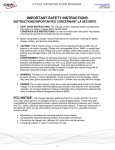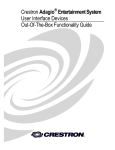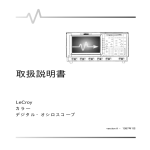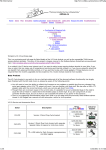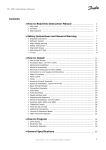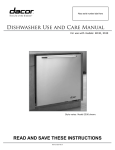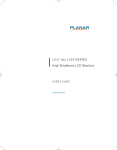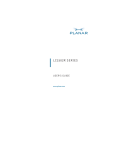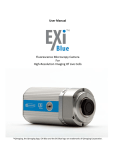Download Cycle Satiator User Manual - Preliminary
Transcript
Cycle Satiator User Manual - Preliminary Congratulations on the purchase of this Cycle Satiator universal charger, for use with all kinds of 24-48V nominal battery packs. We hope that this one device serves you and your batteries for years to come. 1. Basic Overview The Satiator was designed with a narrow and compact form factor so that it could be used either as a portable stand-alone charger, or mounted to the frame of your bike/vehicle as an onboard charger. It has an AC input power port on the side, (100-240V AC), a DC output cable to connect the charger to the battery, a graphical display screen for showing the current charging status, and a pair of buttons to navigate the charger menu. Mounting Flange AC Input Jack DC Output Display Screen Up/Down Buttons (Hold to Select) While most battery chargers are limited to charging one specific battery type and voltage, the Satiator is programmable so that you can choose between a number of battery charge behaviours. You could use it to charge a 24V lead acid pack one day, and a 48V lithium ebike battery the next. This adjustability is extremely useful. It means a separate charger is no longer needed for each of your batteries, and when you upgrade to a new pack, the Satiator can be configured to match even if the voltage and chemistry are different. It also allows you to select between rapid charge rates for top-up convenience and conservative overnight charging to maximize battery life. However, the ability to charge multiple battery types with the same charger also introduces the risk of selecting an incorrect profile when charging your battery. For that reason we recommend caution before enabling multiple charge profiles on the device. In the safest and default configuration, you only have the charger set up with one profile suitable to your primary battery. 2. Getting Started The Satiator does not have an ON/OFF switch, so it will turn on whenever there is power present on the AC input port. The 3-pin IEC connector is the familiar standard for personal computers, and if the included cable does not match your country's outlet standard then there should be no problem finding one locally. Just be sure to use a grounded 3-pin outlet. 2.1.Setting up your First Profile The Satiator is supplied out of the box without any profiles active. Before you can use it to charge a battery, you will need to select an output appropriate for your pack. Once powered on, the display will say "no profiles active" after briefly showing a splash screen. Pressing the up or down button will let you scroll through a number of preset profiles. When you see the profile for your battery, press and hold either button to select it. A screen will ask you to confirm the selection. The preset profiles are shown in the table below and cover the majority of lithium and lead acid batteries encountered in ebike applications Title: Subtitle: Bulk Amps: Full Volts: 36V Lithium Fast Charge 8.0 A 42.0 V 36V Lithium Stnd Charge 4.0 A 42.0 V 36V Lithium 80% Charge 4.0 A 40.5 V 36V LiFePO4 Fast Charge 8.0 A 43.2 V 36V LiFePO4 Stnd Charge 4.0 A 43.2 V Title: Subtitle: Bulk Amps: Full Volts: 48V Lithium Fast Charge 48V Lithium Stnd Charge 48V Lithium 80% Charge 48V LiFePO4 Fast Charge 48V LiFePO4 Stnd Charge 7.0 A 54.5 V 4.0 A 54.5 V 4.0 A 52.6 V 7.0 A 57.6 V 4.0 A 57.6 V Title: Subtitle: Bulk Amps: Full Volts: Float Volts 24V SLA Fast Charge 36V SLA Stnd Charge 48V SLA Stnd Charge 8.0 A 28.8 27.0 4.0 A 43.2 40.5 4.0 A 57.6 54.0 If none of the presets are appropriate for your battery, then you have the option to add a custom profile as well with the "Create New Profile" screen at the end of the list. Custom profile creation is detailed in Section 4. 2.2.Charging Process With just one profile active, the Satiator will start charging the battery whenever it is connected to a pack that isn't fully charged. If there is no battery attached, the display screen will say "Connect Battery" along with a summary of the charge profile. Once it detects a pack has been plugged in, then the charger will automatically start the charge process, and the display will show the charging status in real time. The ability to see the actual amp-hours put into the pack can be of great value in understanding the health of a battery system and allowing the user to rest confident that it has received a full charge. A title bar across the top indicates the case temperature and the set point target voltage. When the charging has finished, the display bar will invert and say "Charge Complete" allowing you to see from a distance that the pack has finished. You will also see a summary of the required charge time as well as the amp-hours and watt-hours put into the pack. When the battery is removed, the screen will return to say "Connect Battery", and if another battery is plugged in then a new charge cycle will begin automatically. 3. Activating Multiple Profiles To setup more than one profile, press and hold the top button on the "Connect Battery" screen to get to the active profile list, and then scroll to the end of the list until you see "Edit Profiles". Hold the button here to access the complete profile list. To the left of each option is a radio button indicating if the profile is active or not. If you scroll through the list and see another profile that you want, press and hold the lower button to edit it. Then press and hold the button again when "Active? - NO" is selected, and this will change to YES. After exiting the edit menu by selecting "Done", you will return to the profile selection screen and will see that the active radio button is now checked. You can activate as many or as few profiles as you like. If you want a profile that isn't one of the presets, then you can create up to 20 custom profiles as described in Section 4, and activate those instead. 3.1.Setting a Default Profile In addition to activating or hiding profiles, you also have the ability to set one profile as your default. This state is indicated by the bold letter "D" under the active button. As there can only be one default at a time, when a new profile is made as default then this status will be removed from the previous default profile. If a default profile is disabled or deleted, then there will be no default profiles in the list. 3.2.Charge Process with Multiple Profiles With more than one profile active, care must be taken to make sure that the correct output mode is selected when charging a pack. The selection behavior depends whether or not a profile has been set as default: 3.2.1. No Default Profile In this case, after the charger is turned on the display screen will show a list of active charge profiles, but the charger will not begin a charge cycle until one of the profiles is explicitly selected. The up and down buttons scroll through the list of active profiles. When the desired profile is displayed, then press and hold the lower button to select it and start the charge process. If a battery was plugged in at the time the profile was selected, then the charge will begin immediately. Otherwise, the charger will say "Connect Battery", showing the profile summary and waiting for a pack to be detected. When the "Connect Battery" text is displayed, it is possible to change active profiles by holding the upper button and repeating the selection process. However once the charge process has started, the active profile is fixed and you cannot go back and change it while the battery is charging. 3.2.2. With Default Profile If you have a default profile, then the charger will always power on with that profile preselected. You can plug in the charger, connect the battery, and charging will automatically start with no button interaction. To select one of the other profiles instead, press and hold the top button before a battery has been plugged in. This will return you back to the profile selection screen, where you can scroll up and down the list and select a new one by holding the lower button. 3.3.Default Profile Usage The use of a default profile is recommended whenever the charger is being used with only one type of battery pack. For instance, you may want a default which provides a standard overnight charge that only gives a 80% charge level at a modest current in order to maximize battery cycle life, but on occasion you may want to do a rapid 8A charge for quick top-up, or give it the full 100% charge when maximum range is needed. All 3 of these profiles are compatible with the same battery pack, so there is little consequence to choosing the wrong one. If you routinely switch between non-compatible batteries (different voltages or chemistries), then you should not use the default profile feature. That way you will always need to explicitly select the correct output for the battery being charged. 4. Creating Custom Profiles If you want an output not available in the preset profiles, then you can setup your own custom charger output with the "Create New Profile" screen at the end of the profile list. You will then select between one of three basic classes of chemistry and associated charge algorithms. 4.1.Lithium The lithium battery has a straightforward charge strategy. The battery is bulk charged at a constant current until the full charge voltage is reached. At that point, the charger maintains the full voltage while the charging current naturally decreases in an exponential decay. Once the current gets close to zero amps, the battery is full and the charger says Charge Complete. If the lithium battery is deeply discharged but not so deep as to cause permanent cell damage (typically between 1.8-2.6 V/cell), then it is advisable to start the charging process at a low trickle current until a safe voltage is reached, and only then switch to the full bulk charge current. If the battery is deeply discharged to a point where any individual cell is dangerously low (typically less than 1.5-2.0V/cell), then a recharge should not be attempted. The low cells may appear to recover, but can exhibit reduced capacity, internal leakage currents, high impedance, and a propensity to catch fire. Figure 1: Charging Graph of Lithium Pack Trickle 40V Bulk Charge Full Voltage Charge Complete 30V 20V 10V Trickle Start A Time (Hrs) When setting up a custom Lithium profile, you are required to set the Full Voltage and Bulk Charge current on the first screen. The 2nd and 3rd screens contain advanced parameters that will be populated to sensible default values, but can be tweaked if desired: Lithium Custom Profile Settings Basic Parameters: Bulk Amps Full Volts Range 0.2-8.0A* 12-60V Advanced Parameters: Min StrtV Start Amps Bulk StrtV Complete A Default 50% of FullV 0.2 A 70% of FullV 0.15 A *Charger will limit to 8A or 360W, whichever is greater Below the "Min StrtV", the charger will not attempt to charge the pack as there is risk that the cells are at a dangerously low level. If the voltage is higher than Min StrtV but less than Bulk StrtV, the charger will put a smaller "Start Amps" current into the pack in order to gently bring the cells to a safe level (as defined by Bulk StartV) before delivering the full bulk charge current. 4.2.Lead Acid (SLA) The charging characteristics of Lead Acid batteries are similar to Lithium batteries, except that after a full charge is complete, the output potential is reduced slightly to a float voltage. This prevents unnecessary reactions and electrolyte loss that can otherwise take place if the battery is held for too long at the full charge potential. Figure 2: Charging Graph of Lead Acid Battery 40V Bulk Charge Full Volts Charge Complete Float Voltage 30V 20V 10V Complete A <FullV Max t Time (Hrs) The profile are setup as follows. Basic: Bulk Amps Full Volts Range 0.2-8.0A* 12-60V Advanced: Min Start V Float Volts Comlete A FullV MaxT Default 6V 94% of FullV 0.15A 4 hrs *Charger will limit to 8A or 360W, whichever is greater The charger will hold the full voltage until either the current drops below "Complete A", or it has been held at the full voltage for "FullV MaxT". At either of these events, the charger output will drop to the float voltage, and the display will show "Charge Complete". To setup an equalizing charge profile for instance, you can set the full voltage about 10% higher than normal, and limit the FullV time to about 2hrs. 4.3.Nickel (NiCad or NiMH) Nickel Cadmium and Nickel Metal Hydride batteries are unique in that their voltage rises and then falls again during the charge cycle, so the strategy of charging to a fixed voltage does not work. Toward the end of the charge process, the battery temperature rises rapidly, and as the pack gets hotter the battery voltage eventually decreases. The end of charge can be detected either by monitoring the battery temperature or by looking for the moment when the voltage starts to decrease, known as -DeltaV. Figure 3: Charging Graph of NiMH / NiCad Pack 40V Start A -DeltaV Bulk Charge Charge Complete 30V 20V dT 10V dt Topping Charge Time (Hrs) Charging based on a temperature sensor is preferred and should always be used when a temperature sensor is available. After the temperature rise is detected, the battery is about 95% charged and the current is greatly reduced while charging is continued for a short amount of time to reach 100% charged status. This is known as the topping charge. If charging at full current is carried on to the –DeltaV point, then the pack has already been somewhat overcharged and there isn't as much need for this additional topping current. The custom parameters for NiMH/NiCad packs are quite different than for the other chemistries. In the basic setup, the nominal rather than the full charge voltage is specified, and is mostly used for pre-populating the advanced parameters and generating the profile name. You can in general use the same NiMH/NiCad profile for several different battery voltages. NiMH / NiCad Custom Profile Parameters NiMH Basic: Bulk Amps Nom. Volts Thermistor Range 1.0-8.0A 12-48V Yes / No Advanced: Start Amps Bulk StrtV DeltaV Max T* dT/dt* TopUp Amps TopUp Time Max V Default 0.5 A 80% of Nom. Volts -0.2V 50oC 1 deg / min 0.5 A 1.0 hr 1.4*Nominal V *only present if "Thrmstr" temperature sensor selected After any of the charge termination methods are detected, then the charger output current reduces to "TopUp Amps" for the fixed duration of "TopUp Time" in order to bring the pack to a 100% full charge. Because the end of charge indicators (Temperature Rise and Voltage Drop) are not pronounced at low charge currents, we recommend a bulk charge current of at least 1/4 the battery capacity. So a 12Ah battery should have at least a 3A bulk charging current. The NiMH/NiCad profile does not run a continuous trickle current into the pack after charge is complete. This technique was common with NiCad batteries to counteract self-discharge and keep the battery 100% topped up, but with NiMH a continuous trickle for a long length of time will damage the cells. If you want a pack to be fully topped up prior to usage, then you should time your charging so that the charge will finish shortly before you will need the battery. 5. Additional Features and Details 5.1.Force Start In some situations, you may have a battery attached to the charger but the charger still says "Connect Battery". For instance, this can happen if the battery has been drained so low that the battery management system's (BMS's) protection circuit has shut off and disabled the battery output. If there is no voltage on the battery terminals, the charger will be unaware that a pack has been plugged in. In this situation, pressing and holding the lower button will force the charger output to go high for a few seconds in order to begin a charge process. If it detects current flowing into the battery with a voltage higher than "MinStart V", the normal charge process will begin. 5.2.Cell Balancing With lithium packs, it can happen that the battery stops charging abruptly because the BMS circuitry has tripped from a cell overvoltage fault. If the battery's management circuit does cell balancing, then this high voltage cell will be bled down to a release voltage and then the charging will resume again. This process can sometimes repeat many times, especially if the pack was largely unbalanced. Even though the charger says "Charge Complete", it will still resume the top up charges as the BMS circuitry allows so that the pack can fully balance out. 5.3.Thermal Rollback The Cycle Satiator operates with much higher efficiency than standard ebike chargers (94-95% versus 80-85%). But it also packs twice the power output into a smaller package and eliminates active fan cooling, so the casing will still get quite warm during use. At full output power in a room temperature environment, it will typically reach about 58 degrees Celsius. This will feel hot to the touch but is not a cause for concern. We recommend placing the charger in a location where it is exposed to free air in order to help dissipate this heat. If the charger is in an enclosed space (like a pannier bag), or is used in a hot environment and starts to overheat, then it will automatically scale back the output power so that the casing does not get beyond 60 Celsius. This will not affect its ability to complete a charge cycle, but it will take longer as charging current will be reduced. 5.4.Exposure to Rain The Cycle Satiator has an IP65 rated sealed enclosure and can handle rain, road spay, and other incidental water exposure when it is not powered up. However, when you have it plugged in and are charging the battery it is important to be in a dry environment outside the rain. The input and battery connectors are not waterproof and there is risk of both corrosion and electric shock if they are powered live when there is water around. 5.5.Orientation and Vent In general, the Cycle Satiator is easiest to operate when right side up, but it will run and function fine in any orientation. The only caveat is that the membrane vent on the input end of the charger should not be covered in water, so if it is mounted vertically care should be taken that it is not done in such a way that water pools around this vent area. 5.6.Thermistor The 3rd pin of the XLR charge plug can be used in conjunction with a thermistor for sensing pack temperature. This is recommended with NiMH and NiCad batteries. The charger expects a thermistor with 10kOhm resistance at room temperature, and a Beta constant between 3800-4000. This thermistor spec is common in industry with nickel based packs. 5.7.Upgrading Firmware The firmware and stock profile list on the Satiator can both be updated via an optional USB adapter plug that connects to the charge port and a computer. Details on re-flashing the firmware are available with the USB communication cable. 6. FCC Notice This charger has been tested and found to comply with Part 15 of the FCC rules, which governs the emission limits for a Class B digital device. These limits offer reasonable but not guaranteed protection against electrical interference between your charger and TV’s, radios, and other radio-frequency communication devices. If electrical interference is still detected, which can be confirmed by turning the charger off and on, possible corrective actions include: • • • • Reorienting or relocating the receiving antenna of your device Increasing the separate distance between the charger and receiver Connecting the charger into a different AC outlet circuit as the receiver Consulting a dealer or radio/TV technician for help 7. Specifications 7.1.Electrical Input Range Output Range Operating Efficiency Power Factor No Load AC Power Input/Output Isolation Grounding Output Leakage 100-240VAC 50-60Hz 24-60V, 0-8A, 0-360 Watts 95% @ 230V, 94% @ 120V >99% <1 Watt Reinforced Insulation, Tested to 3.75 kV Grounded Chassis, DC Output Floating <100uA at 60V (>600 kΩ Impedance) 7.2.Mechanical Dimensions Weight IP Rating Chassis Material 237 x 78 x 48 mm 1.06 kg (1.33 kg with AC-DC cords) IP40 charging, IP65 non-operating Powdercoated Aluminum 7.3.Connectors / Cables AC Input Connector AC Input Cable DC Output Connector DC Output Cable IEC320-C14 2m with IEC320-C13 / NEMA-15 plugs IP67 10A MULTICOMP/SINGATRON 2CT3002-W03400 1m with 3-Pin Neutrik XLR, (1=DC+, 2=DC-, 3=Signal) 7.4.Environmental Operating Temperature Storage Temperature -30⁰C to +50⁰C (-22⁰F to 122゚F) (Note: Output Power Derated >30⁰C) -40⁰C to +60⁰C (-40⁰F to 140⁰F) 7.5.Certifications Safety Emissions Immunity UL 1012, CSA C22.2 No. 107.2, CE / IEC 60335-1/2-29 FCC Part 15 B, EN55014, EN 61000-3-2, EN 61000-3-3 EN 61000-4-2/-3/-4/-5/-6/-11 7.6.Protection Output Short Circuit Reverse Battery Over-Voltage Under-Voltage Over-Current Over-Temperature Requires manual power reset Output disabled when reverse voltage detected. Internal fuse protection if output disable overridden Output disabled if battery voltage exceeds Max Setpoint Output disabled if battery voltage less than Min Setpoint (with option for manual override) Charger output disabled if current exceeds Max Setpoint Output current reduced to limit enclosure temp to <60⁰C













